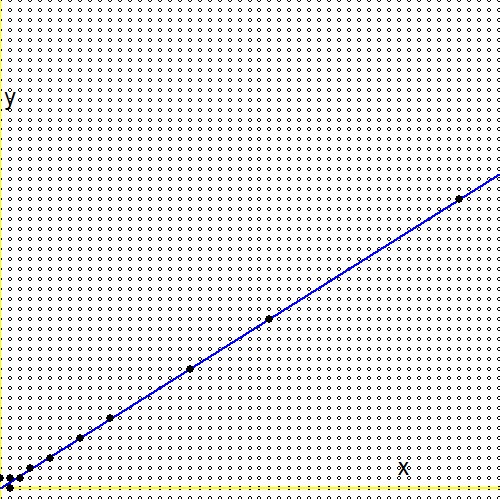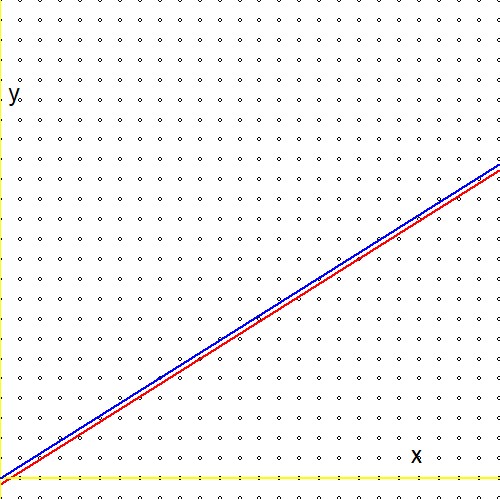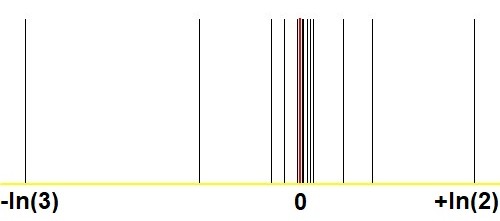Prerequisite reading:
- Can any positive real be approximated as $2^m/3^n$ with $(m,n)$ large enough?
- Stern Brocot tree sequence
Something unsatisfactory is going on with convergence of $\,2^m/3^n\,$ towards a positive real $\,r\,$. As soon as we have reached sufficient approximation,
the next step in our current iteration procedure is to increase $\,m \to m+1\,$ if $\,2^m/3^n < r\,$ or to increase $\,n \to n+1\,$ if $\,2^m/3^n > r\,$.
But then we have actually destroyed our approximation so far, according to $\,2^m/3^n \to 2.2^m/3^n\,$ or $\,2^m/3^n \to 2^m/3^n/3\,$ respectively.
Thus it looks like we are starting all over every time again without making much progress. The number of iterations needed indeed is very large.
Reason why I have been looking for a procedure that does not have this drawback, i.e. where the next approximation is always closer to the desired outcome.
This is what I have tried so far.
According to question (2.),
for every positive real number $0 \lt g \lt 1$ , there exists an infinite sequence in the Stern Brocot tree [ .. ] that converges to the real number.
Meanwhile, this question has an answer,
and the main result in there reads as follows:
$$
- \frac{1}{n_1(n_1+n_2)} \lt g - \frac{m_1+m_2}{n_1+n_2} \lt \frac{1}{(n_1+n_2)n_2}
$$
In view of question (1.), we substitute $\ln(2)/\ln(3)$ for that number $g$. Then it follows that:
$$
- \frac{1}{n_1(n_1+n_2)} \lt \frac{\ln(2)}{\ln(3)} - \frac{m_1+m_2}{n_1+n_2} \lt \frac{1}{(n_1+n_2)n_2} \\
- \frac{\ln(3)}{n_1} \lt \ln(2)(n_1+n_2) - \ln(3)(m_1+m_2) \lt + \frac{\ln(3)}{n_2} \\
\ln\left(3^{-1/n_1}\right) \lt \ln\left(\frac{2^{n_1+n_2}}{3^{m_1+m_2}}\right) \lt \ln\left(3^{+1/n_2}\right) \\
3^{-1/n_1} \lt \frac{2^{n_1+n_2}}{3^{m_1+m_2}} \lt 3^{+1/n_2}
$$
The search through the Stern-Brocot tree can be pictured. The blue line is the function $\,\color{blue}{x\ln(2)-y\ln(3)=0}\,$, small circles are fractions,
mapped on a grid $\,m/n \to (m,n)\,$, massively black filled dots are the fractions in the Stern-Brocot tree. It is seen that searching through
the tree is much more efficient than increasing $m$ and $n$ with increments one at a time.

Now compare the expression at the second line of the above formulas with an analogous expression in reference (1.):
$$
\ln(2)(n_1+n_2) - \ln(3)(m_1+m_2) \quad \Longleftrightarrow \quad m\ln(2) - n\ln(3) - \ln(r)
$$
And be prepared for a disappointment: the logarithm of the arbitrary real $r$ is missing! Or alternatively: $\ln(r)=0$ or $r=1$.
This means that our "infinite search" through the Stern-Brocot tree, though highly efficient, finally arrives at an approximation only for the number one.
I find this weird, because - graphically - there doesn't seem to be a great difference between $\color{red}{2^m/3^n \to r}$ and $\color{blue}{2^m/3^n \to 1}$:

Hence the QUESTION: does there exist a means for adapting the Stern-Brocot procedure such that it works for reals other than one?
EDIT.
Here comes another graph that shows the astonishing convergence with the Stern-Brocot method, in comparison with analogous pictures in my Q & A
Can any positive real be approximated as $2^m/3^n$ with $(m,n)$ large enough? :




